Huronia Players was founded in 1962 in Midland, Ontario. Through that 50+ year history, there have been many adventures. Below is a brief history of the group as told by some of the founding members.
Introduction
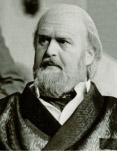
“Over the past 50 years Huronia Players has grown from a small collection of friends getting together to have fun and put on some plays, to a multi-faceted community theatre group. In addition to mounting close to 200 productions, we have provided opportunities for the community to be involved in theatre arts through workshops, Studio Nights, youth camps and classes, as well as special productions for businesses, organizations and seniors’ residences. Each year, we present the Huronia Players Award, our scholarship to a student pursuing the performing arts at the post-secondary level. The group and its members have won a number of awards, notably in the ACT-CO Festival competitions. It has been a great half-century!”
– Raymond Holt (on the occasion of the Huronia Players 50th anniversary)
The Early Years
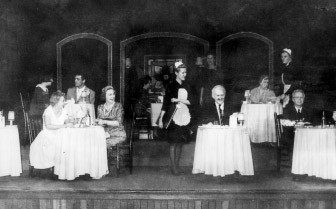
“The first meeting called by Elinor McKean was largely made up of High School teachers – Art & Marty Southcott, Anne Lepan, Grace McMullen, Connie Cardenas, John Hansler, Chris Thomson, Sheila McSpurren along with Doreen McCurry and Rita Groves. They decided to put on a play for fun.”
“English emigration had a big influence on Huronia Players with many war brides – Joan Hannah, May Barber (Williams). There was the opinion that Midland was a ‘cultural desert’ and desperately needed arts input.”
“We had occasional rehearsals in the Armories on Yonge St. (now the Court House), and were served food by the “resident army chef” at backstage parties.”
“The group was committed to training. With the help of grants, we were able to hire a professional director three years in a row.”
“My husband Bill suggested the name Huronia Players.”
– Joan Hannah
“In November 1969 the play Sleeping Beauty was performed for young audiences at the Elmvale Community Centre. Joan Hanna, playing the Wicked Witch, was one of many characters who had to make an entrance through the audience. This required her to charge offstage, climb out the fire exit, run up the alley, and enter, panting, through the front door. En route she met up with two men coming out of the local bar. They couldn’t believe their eyes and probably swore off liquor forever!”
– Raymond Holt
“The group has had some challenges through the years. We were always moving sets from venue to venue and in and out of storage spaces. We used Mac’s Milk (who had a flood while our things were stored there), the basement of the nursing home in Penetang, a house across from Johnson’s Fruit market, Coney Island Auto Wrecker’s barn (including attendant mice), Snider’s transport trailer and most recently, a commercial storage unit.”
“Some of the rehearsal spaces were Glen Campbell’s Dance Studio, the basement of the People’s Store in Midland, over the bowling alley with its missing windows, and the basement of the YMCA.”
– Audrey Hamilton
The Studio
Although the Players had been tossing around the idea of using the Studio as a performance space, it was Betony Main and a group of high school and university students who showed it could be done.
In the summer of 2000, the “Studio Company” cleared out the big room, hung curtains, brought in seating and ‘put on a show’. Suddenly it was more than just an idea.
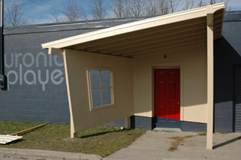
“In the spring of 2003, I was the first person to take on the challenge of directing one of our season’s productions at The Studio. We made the assumption that the space would always be too small for a box set and I prefer a simple set, so I took on Twelve Angry Jurors. Ron Payne later proved us wrong with his elaborate sets.”
– Chris Thomson
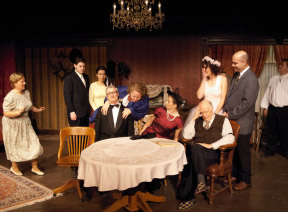
“I directed You Can’t take it with You twice – once in 1978 and again in 2007. In The Studio the complex box set extended right back to the wall – no crossover. After the set was built I realized six people who exited stage left were trapped in a 6′ x 6′ foot area.”
“This play had 18 actors and at one point they were all on stage. When off stage they crowded into the ‘dressing room’ – the office and the small corridor outside.”
“Working in community theatre requires lots of skills in innovation. Access to the stage at the Studio involved a very awkward curtain over the same entry door used by the audience. One day, I took a sledgehammer and made a door through the bathroom so the actors could have an entrance and exit stage right.”
– Ron Payne
The Huronia Players’ Theatre – Our New Home
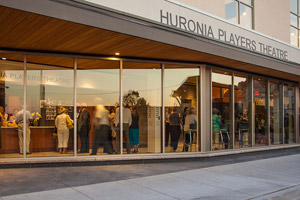
Almost from the group’s inception, venues and storage were a constant worry. As early as 1970, the search was on for a permanent home for Huronia Players.
Every possibility was explored – St. Mark’s Parish Hall, The Armories, the former YMCA and the Roxy Theatre were all considered but ultimately rejected.
When the William St. Studio was acquired from The Town, plans were drawn up to modify that property. Fund-raising began in earnest.
Audrey Hamilton had sent many letters of request to Reinhart Weber, and in 2007, he was ready to hear the proposal for a much more ambitious expansion of The Studio property. Although that plan and another to utilize the former Regent School did not materialize, Mr. Weber had developed a vision for a multi-use Arts Centre.
Ultimately, the old Roxy Theatre was purchased and the sadly dilapidated building demolished to make way for the Midland Cultural Centre. Huronia Players was to have its home!

